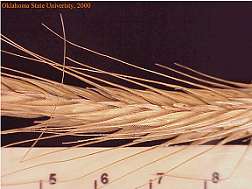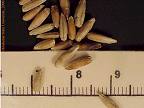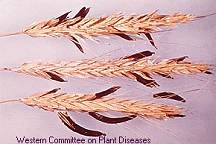|
|
 |
| Welcome | Getting Started | Resources | Site Map |
Week 2
High-Energy Feedstuffs |
Instructions for listening to audio clips
- Download the QuickTime Player to listen to the audio files.
- Read the QuickTime Instructions for installation help.
- Download the RealPlayer to listen to the audio files
- Instructions are on the RealPlayer download page
Rye
Time: 1.58
Follow along with the audio...
- In U.S., not important cereal grain
- Hardiest cereal grain
- Cold temperatures
- Poor soils
- Short growing seasons
- Figure 4.19 – Head of rye grain
- Figure 4.20 – Rye grain
- Nutritional value
- Table 4.7 – Average nutrient composition of rye


Nutrient |
Average Composition,
% |
|---|---|
Crude protein |
13.4 |
Ether extract |
1.8 |
Crude fiber |
2.6 |
Ash |
2.1 |
NFE |
80.1 |
Starch |
63.8 |
- Nutrients – similar to wheat
- Production results – dissimilar to wheat
- Deleterious factors
- Ergot infection
- Figure 4.21– Ergot on a cereal grain
- Fungus
- Produces ergot alkaloids
- Effects on animals – gangrene, reduced reproduction efficiency, reduced gain and efficiency, and neurological disorders
- Rye more susceptible than wheat
- Alkyl resorcinols
- Phenolic compounds
- Reduce intake
- Pectins and pectosans
- Primarily monogastrics
- Feeding livestock
- Relatively unpalatable
- For poultry, typically not fed
- For swine, fed to young
- For cattle
- Limit amount fed
- Amount depends on class of animal

| |
| Welcome | Getting Started | Resources | SiteMap |